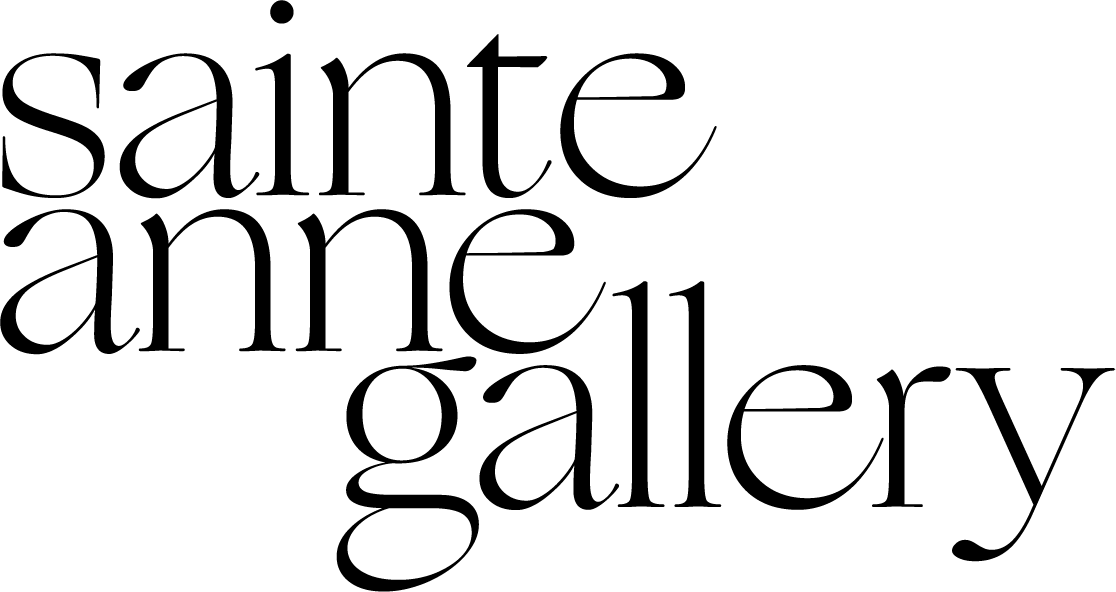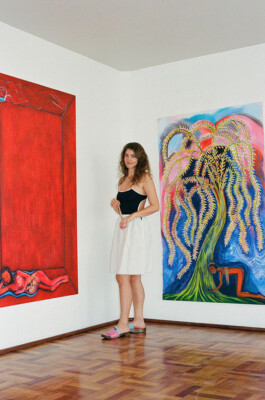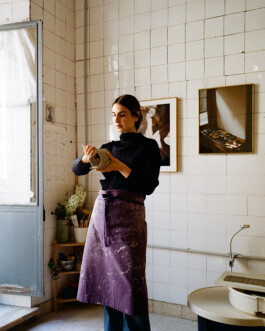


Staring at the Sun
with Cecilia Granara & Marta Cypel
Curated by Francesca Sabatini
15 October — 14 December 2025
Staring at the sun, perhaps we can all agree, is a terrible idea. Yet there is something exhilarating about the simultaneous danger and comfort ushered by this most precious star, to destroy our sight and make it possible at all. Contrast, dilemma and duality are the cornerstones of this exhibition, which brings together the practices of painter Cecilia Granara and ceramicist Marta Cypel. Their joint exploration of the joys and discomforts of creation unravel throughout the spaces of Sainte Anne Gallery, mirroring and responding to each other in a dialogue of form, colour and light.
I am perpetually charmed by these two women’s earnest, relentless, perhaps even slightly unhinged relationship to freedom; and how both have made it the cornerstone of their practices.
The exhibition finds its starting point in Cecilia and Marta’s immediate understanding of each other’s intuitive, quasi-spiritual approach to artistic research, which goes well beyond their respective mediums — painting and ceramics — and use of colour, form and figuration. The title, taken from Irvin Yalom’s eponymous book, echoes notions of the dread of death, as well as regeneration, particularly within the earth, and the reconciliation of mortal anxieties emerging from grief and trauma. Laying on our backs, basking in the sun, it does not matter if our eyes are open or closed, if we are alive or not, above or below ground: the sun washes through and beyond us, merging life and death, resilience and renewal under its magnanimous light.
Cecilia's bright compositions veer increasingly towards abstraction and Marta's organic ceramic mirror structures invest the spaces of Sainte Anne Gallery in a dialogue that unites their voices in a subtle, albeit unapologetic celebration of creation’s eternal pulse.
With uncanny clarity, Cecilia’s paintings convey an otherworldly energy whilst retaining a divine sense of mystery. Colours burst across the canvas, radiating in streams of deep blues and carmine halos, from and into the hands and heads of doll-like figures. Depicted in gentle, almost affectionate brushstrokes, her protagonists may appear peripheral to the compositions, until we realise that they are one with the liquid light that they create and are enveloped in. Inspired alternatively by reiki — Solutio mythology —Tramonto (coucher de soleil), or tarot Riding With Life — each work offers a reinterpretation of universal tropes, addressing loss, death, rebirth and battle. Like the steps through the journey of life, Cecilia guides us from Sunset - Tramonto (coucher de soleil) where a woman battles with a satyr at dusk, to Awakening (Éveil, risveglio) where the body and soul resurrect.
Conversely, Marta’s ceramics, which she merges with brass and mirrors for the first time, address notions of transformation and infinity, using the mirror as a portal towards to the horizon. The Cosmo specchi, They say eyes don’t lie, are mirrors framed in organic, lace-like ceramics, small enough to frame only the eyes, leaving the body’s fleeting imperfections outside the frame. By isolating the gaze, Cypel opens a space for connection beyond the body and its fragile, changing materiality.
“Five years ago, during the pandemic, I was diagnosed with blood cancer. I lost my hair within ten days, my skin turned green. Looking at myself in the mirror became almost an experiment, the only recognizable features of my previous self were my eyes. Strangely, at that same moment, the world was hiding its faces behind masks, framing the gaze was actually a very common experience at the time “
Her large-scale wall installation, Amor Fati, or To the Space in Between, mirrors Cecilia’s canvases in a triptych of two reflective surfaces and a vertical column of eight clay beads. Inspired by Fausto Melotti’s miniature theatrical structures, it stages eternity through the infinite reflection of the beads, set against the tension between life and death. The work becomes a meditation on accepting existence, where each ceramic bead embodies the knot of causes that binds us. Since we return eternally to these knots of life: let us learn how to love them.
– Francesca Sabatini
Francesca Sabatini is based in Paris where she works as a communications specialist in contemporary art and fashion. From 2020 to 2024 she led an independent curatorial project called The Pole Gallery Paris, and she regularly collaborates with emerging artists, galleries and independent exhibition spaces.

Cecilia Granara in her studio in Mexico city captured by @DNA_magazine; photo: @pamyrangel; styling @paurangel @vvalquesada
Cecilia Granara was born in Jeddah, Saudi Arabia, in 1991 and raised between Italy, Mexico, the United States and France. She is now based in Mexico City, where she has established herself as a painter whose work is as grounded in art historical research as it is in contemporary explorations of the body and identity.
Her exhibitions across Europe and internationally have positioned her as a voice attuned to painting’s capacity for both intimacy and collectivity, often framing the act of painting itself as a ritual of presence and encounter. She has presented solo and duo exhibitions at Cassina Projects in Milan, CAC Passerelle in Brittany, Exo Exo in Paris, and Sapling Gallery in London. Granara participated in institutional group shows at Musée D'Orsay (FR), Ford Foundation Gallery (U.S.A.) , FRAC Corsica (FR), Fondation Pernod Ricard (FR), Triennale Milano (IT), Château La Coste (FR), LAAC Musée de Dunkerque (FR), Centre D'Art Contemporain Passerelle (FR), Centre d'Art Parc Saint Léger (FR), Musée Cérès Franco (FR), Zeyrek Cynili Hammam Museum (Turkey), MAXXI, Rome (IT) and ps120 Berlin (Germany). Granara was a finalist of the Antoine Marin Prize in 2019, the Cairo Prize (Italy) in 2021, the Club GAMEC Prize (Italy) in 2024, and the MAC Lissone Prize (Italy) in 2025.

The artist Marta Cypel photographed in her studio in Lisbon. © Alix Vossieg
Marta Cypel (b. 1990, Milan) is an Italian ceramic artist based in Lisbon. After several years working in communication and finance in Paris, she established her studio in Portugal, where she creates sculptural and functional pieces presented in group exhibitions in France, Portugal and Turkey. Her practice is rooted in geology and natural transformation, treating clay as both material and memory. Profoundly marked by a pivotal life experience in 2020, Cypel reflects on legacy and continuity: “If I die, what would I leave behind? … Today I see these ceramic vessels as carriers of memory, my pieces act as storytellers, tangible links between a past heritage, the present and an imagined future.”